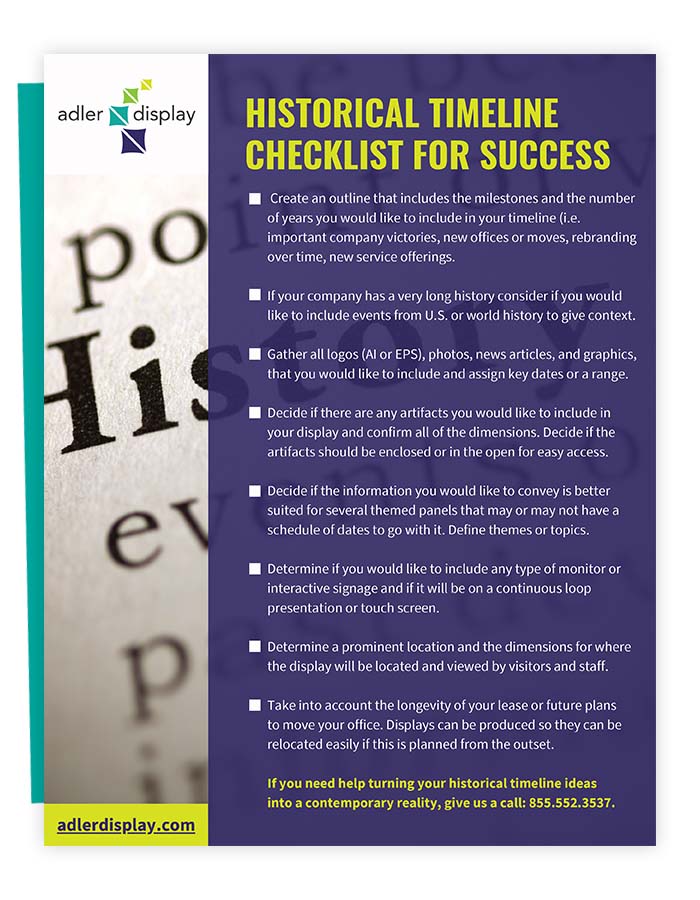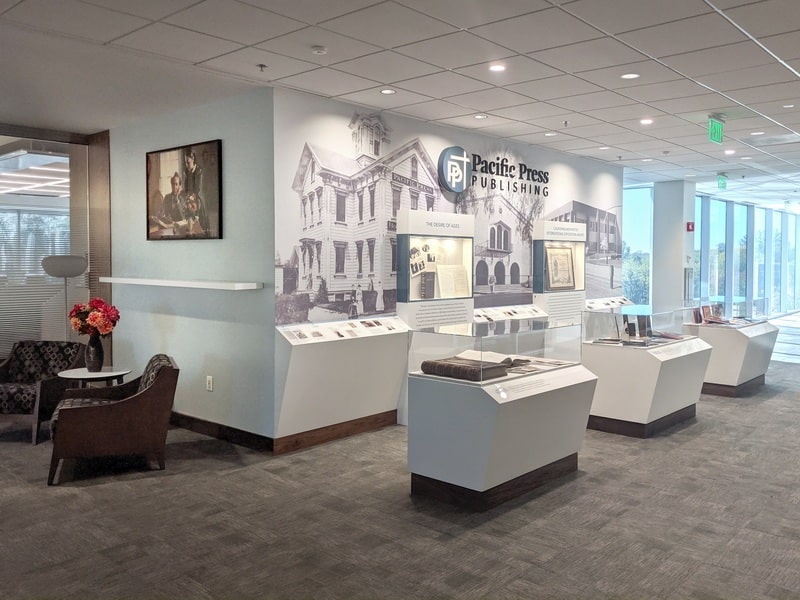The strongest creative ideas for a historical timeline start with taking a closer look at the moments and memories that have guided your journey so far.
Every organization has a past filled with memorable moments, proud milestones, and lessons that have shaped its identity over time. The way that history is shared makes a difference. A captivating timeline does more than list dates on a wall. It gives viewers an engaging visual experience that draws them in, sparks interest, and depicts how the story has unfolded.
Historical timelines are one of Adler Display’s favorite ways to help organizations celebrate their evolution. When visitors can follow your path across different time periods, they immediately feel more connected.
Here are eight fresh, creative ideas for a historical timeline that brings your unique journey to life.
1. Build a timeline flow that pulls people in.
A great timeline starts with structure. Instead of dropping dates in order, think about the big moments that shaped your organization. What were the turning points? What changed your direction? What moments are you most proud of?
Shaping those details into a simple narrative flow helps visitors move from one milestone to the next with ease. It also makes the whole display feel more intentional and engaging.
2. Mix materials to add dimension and personality.
Materials make a dramatic difference in how a timeline feels. By blending textures like metal, acrylic, wood, or printed graphics, you can add depth and visual interest. Details such as raised lettering, layered panels, or cut-out shapes make each section feel more dynamic.
Lighting can give these elements an extra boost. Soft backlighting or small spotlights make important milestones stand out without overwhelming the display.
3. Organize your creative timeline by themes, not just dates.
Dates are helpful, but themes can tell a richer story. Consider grouping your timeline by ideas like Innovation, Leadership, Community Impact, or Milestones. This lets people move right to the parts of your history that inspire them most.
It also breaks your journey into smaller sections, making the display feel warm and approachable rather than dense or overwhelming.
4. Bring each era to life with compelling visuals.
Images give a timeline charm and personality. Photos, sketches, maps, and archival documents make your history feel more real and more relatable. You might include:

- Vintage photos or building shots
- “Then and now” comparisons
- Logos or branding from past eras
- Marketing materials or event flyers
- Portraits of key contributors such as: founders, employees, donors, volunteers…
These visuals help people connect emotionally with your evolution and understand the significance of each time period.
5. Incorporate features that make your timeline feel immersive and contemporary.
It’s easy to add depth and detail without making the display feel crowded. Touchscreens might allow visitors to click through extended timelines or explore different departments, eras, or themes. QR codes can link to videos, photo galleries, or deeper dives into specific events. Layered components work especially well for organizations with long histories or extensive imagery.
6. Create little discoveries along the way.
Small special moments encourage people to stop, explore, and enjoy the timeline at their own pace. Consider adding:
- Hidden symbols or quotes
- Lift panels that reveal fun facts
- Small drawers with replicas or artifacts
- Trivia woven into the design
Touches like these add personality and make the experience more memorable.
7. Showcase the people who made an impact.
Timelines resonate most when they highlight the individuals behind the milestones. Include short profiles, photos, or personal quotes from founders, long-time team members, donors, or community partners. These human moments help your display feel relatable and heartfelt.
It’s a simple way to show gratitude and remind visitors that your success has always been a team effort.
8. Add a glimpse of what’s ahead.
A strong timeline doesn’t stop with the present. Adding a “What’s Next” section featuring upcoming goals, future projects, or long-term plans gives your display a sense of excitement and momentum. It shows visitors that your journey is ongoing and that the next chapter is already in motion.
A historical timeline is much more than a wall feature. It’s your opportunity to celebrate where you’ve been and show how far you’ve come. When you bring in creative ideas for a historical timeline, like themed sections, layered visuals, and engaging design details, you can create a fascinating display that invites people into your journey.

Turn Your Historical Timeline Ideas into Contemporary Reality
Download your FREE checklist by clicking the button below. Happy Reading!
Historical Timeline Checklist Opt-In
If you’re ready to turn your history into something eye-catching and meaningful, Adler Display can help. Our talented team will design a timeline that captures your unique identity and resonates with everyone who views it. Contact us today to get started.
About Adler Display: For over 85 years, Adler Display has been one of the best-kept secrets behind so many businesses looking their best. Designing and producing a wide variety of high-quality recognition displays, trade show displays, signage and exhibits, lobby and corporate interiors, and historical timelines, Adler’s expert team includes consultants, designers, project managers, and fabricators. Working from a 17,000-square-foot facility in Baltimore that includes a precision woodworking shop, Adler Display handles printing, construction, and finishing on site. Learn how to achieve your imaging goals and make your business look amazing at: www.AdlerDisplay.com.

